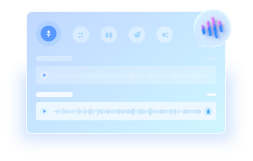-
![]()
Sofia Albert
Sofia has been involved with tech ever since she joined the EaseUS editor team in March 2011 and now she is a senior website editor. She is good at solving various issues, such as video downloading and recording.…Read full bio -
![]()
Alin
Alin is a sophisticated editor for EaseUS in tech blog writing. She is proficient in writing articles related to screen recording, voice changing, and PDF file editing. She also wrote blogs about data recovery, disk partitioning, data backup, etc.…Read full bio -
Jean has been working as a professional website editor for quite a long time. Her articles focus on topics of computer backup, data security tips, data recovery, and disk partitioning. Also, she writes many guides and tutorials on PC hardware & software troubleshooting. She keeps two lovely parrots and likes making vlogs of pets. With experience in video recording and video editing, she starts writing blogs on multimedia topics now.…Read full bio
-
![]()
Gorilla
Gorilla joined EaseUS in 2022. As a smartphone lover, she stays on top of Android unlocking skills and iOS troubleshooting tips. In addition, she also devotes herself to data recovery and transfer issues.…Read full bio -
![]()
Rel
Rel has always maintained a strong curiosity about the computer field and is committed to the research of the most efficient and practical computer problem solutions.…Read full bio -
![]()
Dawn Tang
Dawn Tang is a seasoned professional with a year-long record of crafting informative Backup & Recovery articles. Currently, she's channeling her expertise into the world of video editing software, embodying adaptability and a passion for mastering new digital domains.…Read full bio -
![]()
Sasha
Sasha is a girl who enjoys researching various electronic products and is dedicated to helping readers solve a wide range of technology-related issues. On EaseUS, she excels at providing readers with concise solutions in audio and video editing.…Read full bio
Content
0 Views |
0 min read
Quick Answer
To find the key of a song by ear:
🔑 Start by identifying the root note, then use pentatonic scales to test different notes until one fits well with the song, though it's important to note that this process is imperfect and requires practice for accuracy.
🔑 For Guitar, find the relative keys, keep playing the song to figure out the major or minor scale, and find the key according to the pentatonic scale pattern.
🔑 For Piano, find the song's tonic while humming, and play in on the pentatonic scale to find the key or root note.
There's no structured formula to find the key of a song. Finding the central key may be confusing even if you have a chord chart. While many believe there's no need to find a key, knowing it helps you improve the song to another level. In this post, we will see how to find the key of a song by ear.
What Is a Key
In music theory, a "Key" refers to the central point or home around which the piece of music revolves. Each key has its music scale consisting of notes arranged in a particular pattern of whole and half steps.
Let's say we are talking about a song in the key of A major; it means that the A major is the song's central point. From there, the following chords start to flow into the song. This home chord is called a tonic or 1 chord (we give the numeral "I" for a major tonic and "i" for a minor tonic. The tonic can be A major, A minor, C major, C minor, etc.
In a numeric progression of music notes, 1 always represents the tonic or key, and other chords follow it. E.g., 1 4 5, 2 5 1, 1 3 6 4. So, in the A major example, our key would be A major, and the lead player starts trying the major pentatonic.
How to Find the Key of a Song by Ear
If you don't have a chord chart or want to figure out what chords you are listening to improve the song, you should learn to find out the key of the song by ear. Knowing the key also helps learn the vocal melodies and understand what to make out of the tunes if you listen to somebody's work.
A key can start from any note, be it minor or major; that is, finding a key means determining two things:
- The note at which the scale starts.
- Major or Minor type of the note.
Step 1. Finding the Root Note
The name for the starting note is the Root note. The Root is the fundamental principle of how music works. The Root note seems like a home, something you can sense as the song's heart.
In any piece of music, and at any given time, the note to which all the chords and melodies gravitate around and fall back. This sense of returning to home is called resolving. Generally, the Root note fits well with everything in the song.
Step 2. Get the Pentatonic Scales
You must get the pentatonic scales to test the root note. Learn about Pentatonic scales, and look at these two scales for reference.
Minor Pentatonic Scale
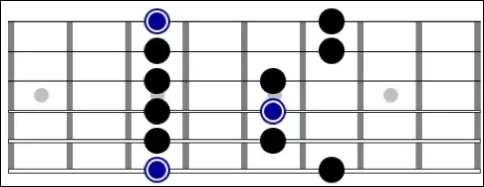
Major Pentatonic Scale
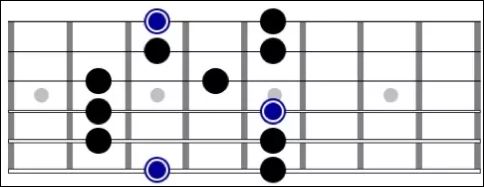
Step 3. Testing the Root note
Use the Minor Pentatonic scale and start playing from the note you think is the Root. If you get the key right, it will go well with the song. You have the key if the Minor Pentatonic scale fits the song.
If it doesn't sound well, move to another note and do the same with the minor scale to figure out the key. Try this until you have all the keys. If none work, you have the wrong Root note or scale. Switch to the Major pentatonic scale if you feel the Root note is right and the scale sounds wrong.
Now, if both the scales do not sound right with the Root note, the root note is wrong. Try the first two steps to find another root note and check the tune with the scales.
To figure out the key with the ear is an imperfect process; even with the process, you can only go up to 90% efficacy. So, be patient, practice a lot, and focus on finding the root note.
How to Locate the Key of a Song by Ear with Your Instruments
So, the above section gives us a generalized approach to finding the key of a song by ear for various instruments. Let us learn how to do it based on instruments, particularly Piano and Guitar, which follow the 12 chords' chromatic scale.
Determine the Key of a Song on Piano
Each octave of the piano has 12 notes. As you find the key, you will narrow it down to the seven typical notes; after that, you can hop onto improvisation.
Step 1. Get into the groove
Play the song, and try to listen to it carefully. Do not overdo it, but naturally dive into the groove to understand the tonics. Find the place of rest (home node) towards which the whole song gravitates.
Step 2. Sing the tonic of the song
In the process of finding the tonic, you will always feel like there's more than one. Keep stressing on the node, which feels like you are returning home, or simply, which feels like the song or beat completes there.
This is where you will stumble upon two melody notes, the first and the last, creating the feeling of rest or resolution. If you are confused about the two, while humming the tonic, try to sing the do-re-mi scale from the note to figure it out. If it feels good, try to do it again; if not, do the same for the other note.
Step 3. Find the note on your instrument.
Take out your piano, and try to hum the note you are trying to find out. Pick a note you feel like matching the song, and start playing. If it doesn't feel right, move up the keyboard in half-step instruments until you find the right note.
The first two steps help you get accustomed to the song's melody. With this, you train your ear to listen to the song in a certain way, to be more sensitive while comparing different intervals, and to improve the feel of the notes and the keys.
Step 4. Play the key scale to confirm the key
Now, you assume you have found the right key for the song or tune. The best step is to test the key scale to establish it. Most songs are played in a major key, and one should know how to play all the major key scales. For this, you should know the major scale in all 12 keys and distinguish between the whole step and a half step.
Get the Key of a Song on Guitar
The guitar also works on the same 12-note pattern, but the method differs slightly from the piano. The trick below helps you get the key right most of the time. Let us quickly look at the steps.
Step 1. You should at least know how to play your major scale to identify a key. Check out the shape of the top string set to know what we are doing here.

Step 2. Let us assume that the shape at the top half of pattern 1 is a classic pentatonic scale with a couple of major notes.

Step 3. Am and C major are relative keys. They are relative because they share the same notes but start at different positions. But surprisingly, the two same notes, staring from different positions, give us two contrasting sounding scales, giving an entirely different vibe.
Step 4. Now, looking at the figure, you can observe that we have two notes right next to each other.

Step 5. We can see the notes more clearly if we spread the scale across one string. You can also notice two notes along the high E string, where we can try playing the 1 3 4 pattern. Here's the deal: one of these positions will be the correct position for the major scale, and the other one sounds bad. Do a trial and error, and pick the one that sounds good.

Check out the YouTube tutorial to see the practical part about how to find the key of a song by ear👂.
![How To Find The KEY Of A Song Completely By EAR [No Perfect Pitch]](/images/multimedia/video-editor/resource/how-to-find-the-key-of-a-song-by-ear.png)
How to Find the Key of a Song Online
Finding the key to a song by ear is an imperfect process. It's a complex process, even for people who practice a lot. Is there an easy way to do it?
Free Song Key Finder -EaseUS Online Key Finder
Upload the audio on the EaseUS Online Key Finder, and our website will find the key for you. It's as simple as that: get rid of the tiring process of going through the notes and scales with our tool.
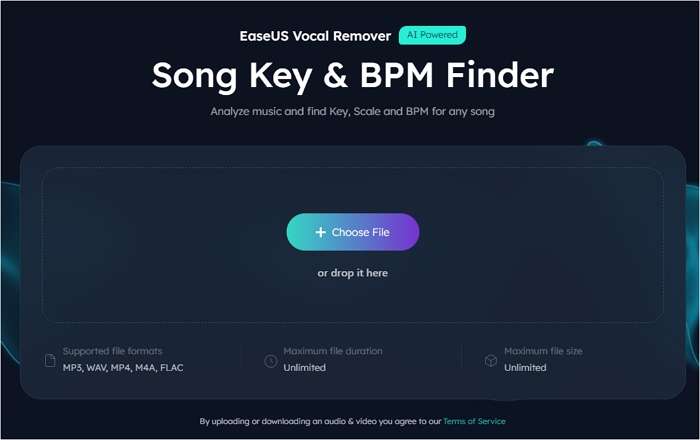
EaseUS Online Key Finder is an AI tool specialized in all audio needs; you can separate vocals, find the key and BPM, speed up, and remove background noise. You can upload any audio file in MP3, WAV, M4A, FLAC, and MP4 format, and the AI tool processes the audio to find the key in just a few seconds. Additionally, you can remove vocals, alter sound parameters, extract instrument sounds, and remove unwanted noise from video and audio.
Key Features
- Find the key of a song for free.
- Boost and reduce audio volume.
- Remove noise from audio online.
- Speed up or slow songs.
Follow the guide below to find the key of a song with EaseUS Online Key Finder:
Step 1. Go to the website and navigate to the "Key BPM Finder."
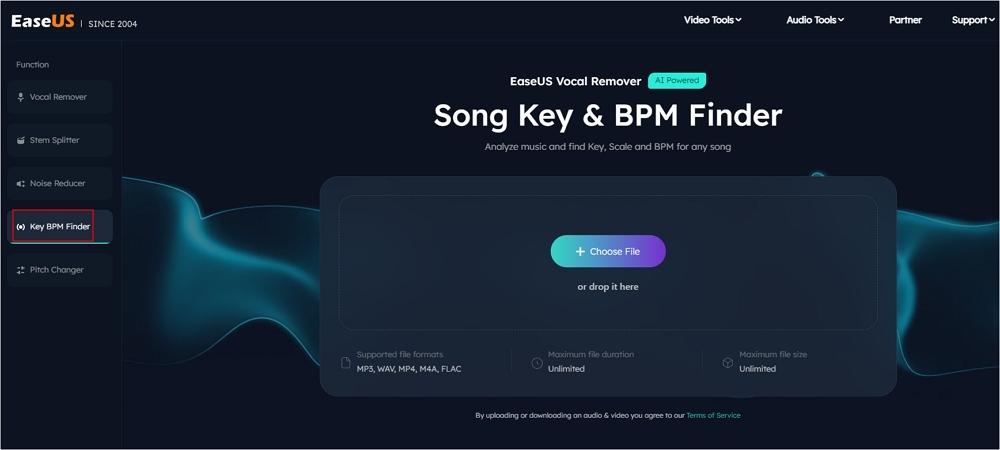
Step 2. Browse the local library or drag and drop the audio here.
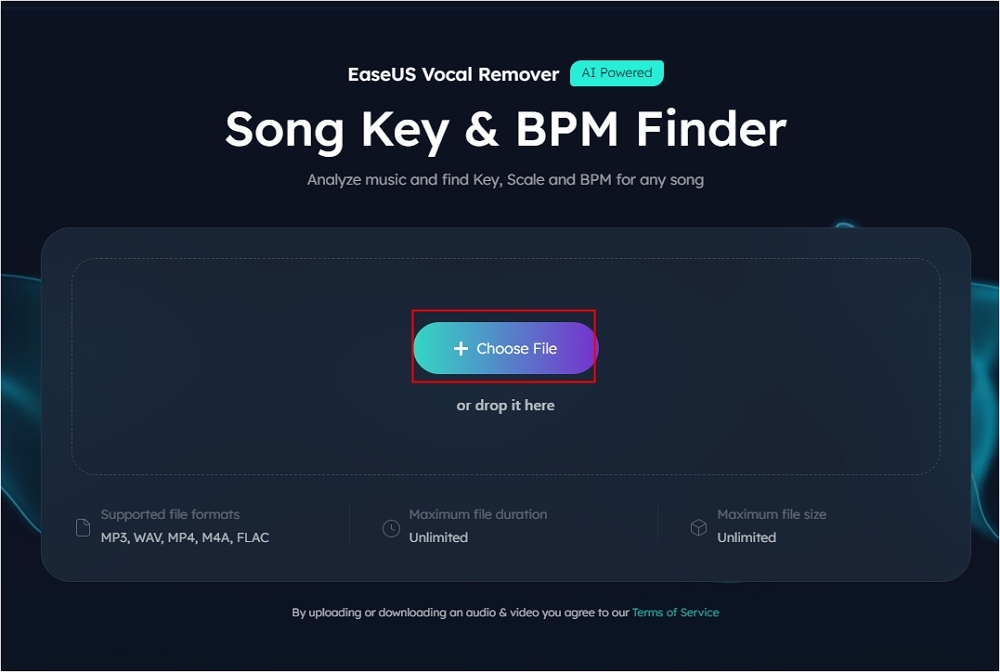
Step 3. The AI will analyze it and show the key of your song. Click "Add Tracks" for multi-tasking. Press "Export .csv File" to keep the record.
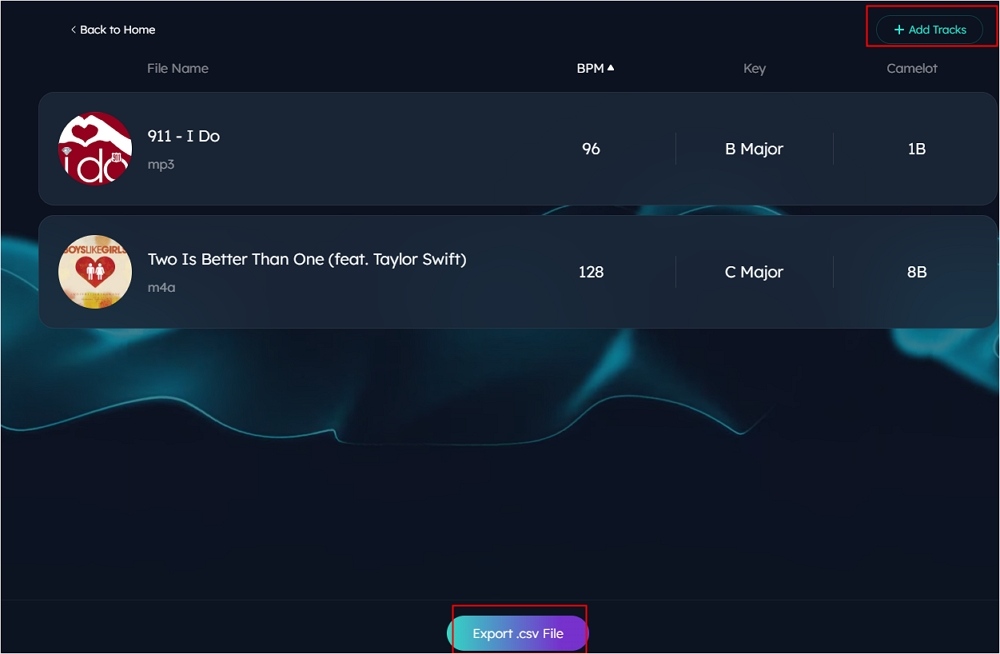
Final Words
It takes a lot of practice to find the key of a song by ear. In this post, we will see how to find the key of a song by ear for guitar and piano, as well as a general method to find the key for any instrument. If you find the process tedious or confusing, the easiest way to find the key is to upload the audio on EaseUS Online Key Finder to let the AI do the job for you.
FAQs About How to Identify the Key of a Song by Ear
Here are some of the most frequently asked questions on how to speed up Spotify songs.
1. How do you find the key of a song with chords?
- 1. Write down all the chords.
- 2. Now, write all the scales associated with each chord.
- 3. Look at all the scales and see if the chord's root notes are within the scale. If yes, it is your key.
2. How do you find the key of a song without key signature?
- 1. Try to identify the root note by humming the song.
- 2. Get the pentatonic scale and test the root note to see if it fits the scale.
- 3. If not, repeat the same steps for the other root notes.
3. Is there an app to identify a song key?
Yes, there are several apps available for identifying the key of a song. Some popular ones include "Auto-Key" and "Song Key Finder." These apps use algorithms to analyze the harmonic content of a song and determine its key.
4. How do I find the notes of a song by ear?
- 1. Hum the first note and try to listen to the notes.
- 2. Try to find the note on the pentatonic scales and see if it feels like the root note or home note.
- 3. Try using the Minor and Major scales to see if it is the song key.
5. How do you tell if a song is major or minor by ear?
We can check if the scale is minor or major using the melody progressions and chords. If your melody's centered around the major scale's 3rd or 6th steps, it is on a minor scale. Similarly, if it is centered around the 1st or 5th, it is a major scale.
